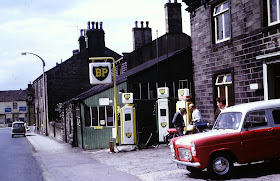Those were the days: when petrol cost 6s.2d. (31p) a gallon
Above: this photograph shows the Bolton Road garage around the 1960s when Bill Mawtus was the owner and before Bell Square was built. The garage abutted the King's Arms forecourt and the petrol pump on the right obscures the pub's mounting steps, which can be seen in the photograph below. The garage's wooden workshop was demolished to make way for Bell Square. Note the 'gents' toilets sign by the low wall. The smart red and white Ford Prefect has a 1960 registration plate (663 WW). Petrol cost 6s.2d (31p) a gallon in 1970 and forecourts had attendants. Weekly wages averaged £32. A loaf of bread cost 9p, a pint of lager 20p.The same scene in 1972, minus the garage, which moved to the other side of the King's Arms, where it continued for a number of years as Longbottom and Green, managed by the late Geoffrey Drake, whose wife, Margaret, still lives in Silsden. Bell Square was built as part of the pre-1974 clearances of unfit housing in Bridge Road by the Urban District Council. The garage site had several different uses after Longbottom and Green closed and is now the home of Jacksons funeral services, in association with Whitlock and Craven.
Demolition and the new lay-out opened up this view towards the Co-op parade of shops in Bridge Street. Photographs of the old streets and buildings before demolition are shown in my blog of April 1st, 2013.

















